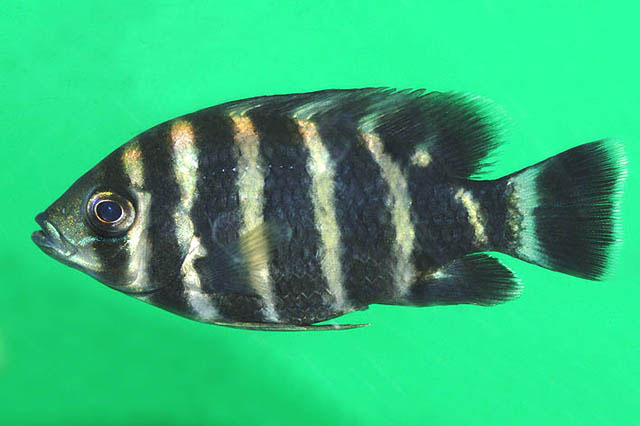| Cichlidae (Cichlids), subfamily: Pseudocrenilabrinae |
| 30.8 cm SL (male/unsexed) |
|
benthopelagic; freshwater; pH range: 6.5 - 7; dH range: 15, |
| Africa: lower reaches of coastal rivers from Guinea-Bissau (Geba and Corubal Rivers) to west Liberia (St. John River)(Ref. 53405). |
|
Dorsal spines (total): 13-15; Dorsal soft rays (total): 14-16; Anal spines: 3-3; Anal soft rays: 10-11. Diagnosis: lower pharyngeal bone about as long as broad, and with anterior lamella shorter than toothed area; median pharyngeal teeth broadened when compared to the lateral teeth; 5-6 series of scales on cheeks; 4.5-6 scales between first dorsal fin spine and upper lateral line; dark vertical bars broader than lighter inter-spaces (Ref. 53405).
Description: body (very) deep (Ref. 52307, 53405), its depth 44.4-52.2% of standard length (Ref. 53405). Frontal profile straight to concave (Ref. 52307). Outer jaw teeth bicuspid, outer jaw teeth and posterior pharyngeal teeth tricuspid; micro-gillrakers present; scales cycloid (Ref. 53405). Caudal fin slightly rounded (Ref. 52307).
Coloration: ground colour yellowish-grey, with 7-8 broad, oblique (forward-directed) brownish-black bars, broader than light spaces between them and extending unto belly; 1st bar at level of eye, last on caudal peduncle; pectoral fins transparent, other fins brownish-black; pelvic fins with light anterior margin (Ref. 53405). Caudal fin with pale outer margin; dorsum of adult males sometimes pale bronze, females always somewhat lighter; lips pale blue; pelvic fins of adults always with elongated rays with a dark color and white anterior edge; older specimens tend to lose bars when comfortable, appearing totally dark gray to black, often with a bluish flush (Ref. 52307). Young: blackish area on chin; vertical bars on dorsal fin matching bars on sides of body which are less oblique than in adults; much darker bar at level of "tilapian" spot, reaching spinous part of anal fin, following bar (1st on caudal peduncle) extending unto soft parts of dorsal and anal fins; caudal fin with vertical bar at base and another at centre (Ref. 53405). |
| Occurs only in larger rivers with rocky substrates, not found in smaller creeks; not specialized, but prefers a herbivorous diet; pair-bonding, biparental open substratum spawner holding very large territories; might spawn throughout the year (Ref. 52307). |
|
Least Concern (LC); Date assessed: 16 January 2020 Ref. (130435)
|
| harmless |
Source and more info: www.fishbase.org. For personal, classroom, and other internal use only. Not for publication.

